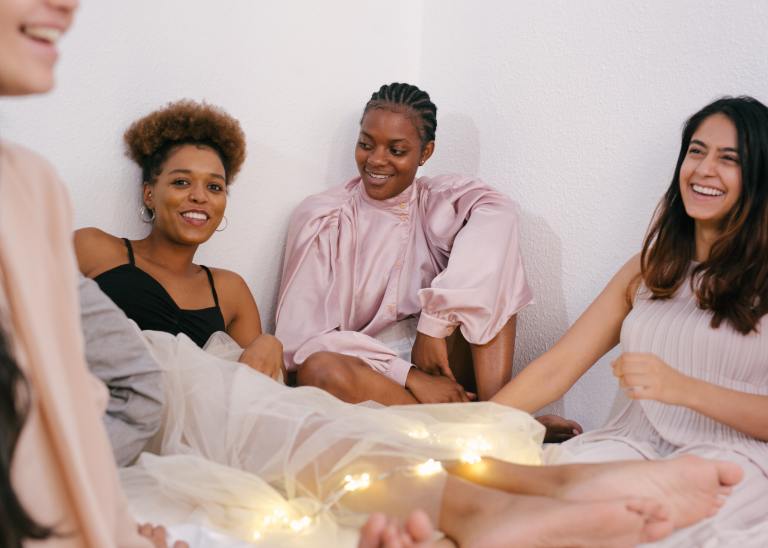
How To Love Our Bodies The Way They’re Meant To Be
Just because we should all partake in practicing healthy eating and exercising habits, doesn’t mean we’ll end up looking like the same type of “healthy.” “Healthy” comes in all different shapes and sizes, and we’re not all meant to be a size 0. Through my own accidental research and experience. I’ve discovered the reasons as to why we all look the way we look and how we can embrace that – recognizing that there is no “perfect weight,” but the weight that’s “perfect for you.” Here are a few factors that come into play in helping you understand and accept why your body is meant to be as is!
Genes
While it may be due to culture, we don’t necessarily look different or similar, because of our ethnicities or races. We possess certain physical characteristics directly due to our relatives or mostly our parents’ DNA. But, our relatives and ancestors at least partially share the same race and background, which explains the pattern of similar physical traits in humans of the same ethnicity. So there is some truth to the reason why people can guess whether you’re apart of a certain ethnicity, while there is more of a difference within humans of a certain ethnicity than humans over a wider range of ethnicities combined. Saying that, weight and body type may result due to genetics as well.
Like those who are European or Middle Eastern, Latinas tend to have that darker hair, darker skin, and – yes – more hourglass or pear-shaped bodies. Take Puerto Rican celeb Jennifer Lopez who has a derriere worth at least over a million dollars, along with her famous name – not to mention Salma Hayek, Selena (R.I.P.), and a few others. Latinas reportably have a higher chance of acquiring heart disease or other related illnesses (due to their body types), but perhaps, their metabolism is mostly genetic – not ethnic.
Some people also struggle with thyroid issues or disorders like PCOS (Poly Cystic Ovarian Syndrome), where they are likely to become/stay overweight and it’s more difficult to lose weight. While being subjected to these illnesses may not justify unhealthy dietary habits, it could require more extensive periods of time, more effort and more restrictive regimens to achieve weight loss. Others should become aware of these issues and understand the challenges many confront because of it. The appropriate remedies, including medication, should be taken into consideration – aside from raising awareness of particular side effects. These disorders, however, could be hereditary.
Body type
Body types can be genetic as much as they’re solely based on the individual. For example, my sister and I could differ in body type more than we do in facial features. Of course, this could apply to generally anything; but while body types range more over a wide demographic than we could compress in siblings, there are four basic body types that remain consistent in either situation. For example, a pear body type is a type of physique that stores majority of weight on the lower half – thereby producing larger glutes, thighs and hips in contrast to smaller stomachs, shoulders and sometimes even breasts ie. think Kim Kardashian, Beyonce, etc. Hourglass body types are considered the most symmetrical; consisting of a tinier waist with bigger curves, ahem, breasts and hips of similar measurements to balance proportions out. Britney Spears and more famously, Marilyn Monroe, are proud owners of this most “iconic figure.” Pun intended. Apple figures store more weight on their upper halves ie. stomach, and “straight” bodies lack defined waists or curves within their bodies – giving a more ‘straight” look.
Studies show it’s technically better to be pear or hourglass, since stomach fat is mostly linked to apple shapes, and stomach fat is more directly connected to diabetes or obesity. Ironically enough though, according to statistics, it’s actually healthier to be “slightly overweight” than of “normal weight,” because that extra weight provides more of a “metabolic cushion” when you’re older. It’s also better to have cellulite if you’re curvier like, for example, Beyonce; as opposed to a thinner star, like Audrina Patridge, because you have more room for the cellulite to distribute evenly over your body.
Bone structure
Here’s the easiest way to explain how you can measure your bone structure. Wrap your thumb and middle finger around your wrist where the “bone” is located. If your thumb and middle finger touch, you have a medium bone structure. If they overlap, you have a small bone structure. If they barely or don’t touch, you have a larger bone structure. If you have a bigger bone structure, you can’t make your bones smaller or your bone structure less wide, so you’re meant to be at least slightly larger than your smaller-boned comrades. For example, a 5’4 woman with a large bone structure can carry 140 lbs well, while a 5’4 woman with a small bone structure may be more comfortable at 120 lbs. Sometimes, you can’t force yourself to be at a lower weight, no matter how hard you try. You should never resort to unsafe means to attain an impossible physique. Determine which weight is best for YOU and your body type, which goes into my next point…
“Set” weight
Models like Crystal Renn have discovered that our bodies always return to the weights their bodies are predetermined to be. Before Crystal Renn became a fashion model, she stood at 5’9 and 175 lbs – a weight appropriate for her height and body type. However, in order to become a straight size fashion model, she was asked to get herself down to a 34 inch waist – which led to her extreme dieting to a mere 98 lbs (that’s over a 70 lb weight loss) and a full-fledged eating disorder for the next few years. While Crystal continued her obsessive eating and exercise rituals, her weight rebelled at her agency’s dismay. When her body started climbing and hit 130 lbs – despite her eating disorder – Crystal couldn’t take it anymore. She accepted the opportunity to become a plus-size model and returned back to her size 12-14 figure. While Crystal may fluctuate from 160-175 lbs and has even hit a fit size 8 at one point or another, she points out in her book Hungry that every body is different and that her body returned back to her set weight – the weight she was meant to be. Even doctors have said: you could give one person an apple and they’d stay the same weight, while another could gain two pounds seemingly “just by looking at it.” Proof that we’re all different, and not all of us can become a size 2 – nor should we.
BMI
Doctors usually rely on the “Body Mass Index” to determine whether their patient is underweight, healthy weight, overweight, or obese. However, the definition of BMI also refers to a “measure of body fat.” And while BMI still gives a wide range of healthy weights for different people of various ages, heights, and body types, it doesn’t fully apply to every single person who has, for example, lost muscle due to aging and excessive dieting, or has more muscle weight due to being an athlete, etc.
Allow me to explain. According to BMI, someone under the range of 18.5 is considered underweight, 18.5-24.9 normal (or healthy) weight, 25-29.9 overweight, and 30 and over obese. But, of course, this isn’t certain – or black and white – for every person who may be just a few pounds overweight or are on the high-end of healthy. For example, a woman who is 5’3-5’4 and 140-145 lbs is considered on the high end of a healthy BMI or a few pounds overweight. And while losing a few pounds wouldn’t hurt – especially if she has a well-proportioned hourglass or pear figure with a bigger bone structure and moderate metabolism – technically, according to the BMI chart, she could lose almost 50 lbs and still be on the low-end of healthy at 100 lbs weight. But, is this necessarily healthy? No, of course not. Even though she would still be within a healthy BMI at 100 lbs, for that reason of a different body type, you wouldn’t expect her to go from a size 10 to a size 0! It just wouldn’t be necessary and with that different body type, it is probably more realistic for her to stay at 130-150 lbs then to be 100, 110, or even 120 lbs. Because she has a specific body type and bone structure, she would really need to malnourish herself to reach that point, hence dangerous dieting habits that can lead to a severe eating disorder – all when she doesn’t even have to!
The same goes for, let’s say, a man who is 200 lbs at 6 feet tall and has a rough BMI of 27. In this case, they’re considered “overweight,” but even if their body fat is slightly higher than it should be and their muscle ratio is lower, I believe a man who is 6 feet tall and 200 lbs is at a standard weight for his height. He’s taller and can get away with more weight, but even so, would that make him less healthy than someone who is all muscle and 300 pounds?
That’s the thing. They say BMI is a measure of body fat, but I really think it’s solely based on your height and weight. A 5’4, 145 lb woman isn’t always going to have 25% body fat (at a BMI of 25). Not only that, but the average woman is 5’4, 164 lbs, and a size 12/14. While this means that the above average woman is overweight and some of the below average women are underweight, does this also mean that the average woman is a plus-size? While some plus-size models may not be considered overweight (or very overweight by BMI’s rules) – because of their tall heights – there’s a reason they call those women “plus size” or have “plus size” clothes. Plus-size is indicated by whether a woman is a size 14 or over (with potentially a larger bone structure or height), not to mention that in the modelling world, a size 8-12 (and sometimes even a size 4 or 6) is considered plus-size. But, if you’re not a plus-size – but a size 6-12 – are you still considered overweight or fuller than the average weight? And if you are, then why aren’t you considered plus size?
There are so many contradictions and grey areas about weight in media and society. Should you really become paranoid with a chart that may not even hold true – for you?
Muscle vs. Fat
But, the other issue here is our society’s obsession with a size 0 figure and the fitness industry’s preoccupation with a ripped figure. Now, I’m NOT saying ALL personal trainers say this, but if you’re – let’s say – outside of your 18%-22% body fat range (as a woman), are you considered fat, even at a healthy weight? For example, there are many women who fit into the 5’5, 150 lbs, and have a high-end healthy BMI or a few pounds overweight, but with 30-ish percent body fat. Are they considered obese at this point? I don’t think it’s fair to put a medium-height, 150 lb person on the same level as a 300 pound person who has high body fat and is clearly obese. It’s not right to call them obese; all it really means is that they have high body fat and need to tone up – and maybe lose a little weight. For example, The Rock would be considered obese if you looked purely at his weight – but it’s obvious his mass consists mostly of muscle…
Natural Metabolism
It works the same way with someone who is naturally petite and no matter how much they eat, will not gain weight, because of their smaller bone structure and extremely high metabolism. I say this, because I know at least five people who have personally battled with this issue. While some of us may prefer to have their metabolism – as opposed to our own (who wouldn’t want to eat whatever they want and still have “abs”?), because their natural body type is healthier and more susceptible to staying at a lower weight, it’s ok if they stay at the lower end of the BMI chart. It’s ok if they stay at that weight, because they don’t have to eliminate so many calories or resort to starvation to attain a certain weight loss or healthy body weight.
Working with YOUR Body
While many factors may contribute to our weight and shape our body types, there are different ways to reach and emphasize the best bodies individually suited for each and every one of us. While personal trainers may focus on the value of weight training, we may disagree and realize different types of exercise work better for us – not just in terms of our fitness levels and preferences, but those activities and their effects on our body types/appearances. For example, Tracy Anderson – a celebrity-based personal trainer who has worked with everyone from Jennifer Lopez to Madonna – believes that utilizing weights may make her female clientele’s bodies look “bulkier,” explaining that any activation in a muscle may enlarge it. She’s even opposed to running and cycling, in fear of the risk of “thunder thighs.” Tracy’s method concentrates on dancing and molding a lean “dancer’s body.” But while running and gymnastics may be responsible for my everlasting “thunder thighs,” I realize I don’t have the luxury or space to dance on a daily basis. And even if I did, I don’t think every single person – including me – would be able to achieve a dancer’s body in every case. While dressing your body type may highlight certain areas and make you look “straighter” or your hips look smaller, you can’t necessarily fake it with exercise. You can’t change your body with a dash of black and a-line skirts; but you can make it look the best you want it to be and show that you’re proud of it! ![]()











